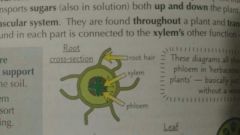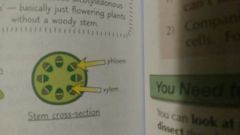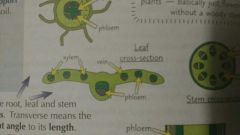![]()
![]()
![]()
Use LEFT and RIGHT arrow keys to navigate between flashcards;
Use UP and DOWN arrow keys to flip the card;
H to show hint;
A reads text to speech;
13 Cards in this Set
- Front
- Back
- 3rd side (hint)
|
Why do multicellular plants need transport systems? |
1.) Because they have a high metabolic rate, each cell needs minerals and hormones for their enzymes etc to function. 2.) Because they have a low SA:V ratio and so cannot rely on diffusion alone for the plant to get what each cell needs. 3.) Because of their size, redwoods can grow up to 115m tall, meaning they need a specialist system to transport food and water to the top. |
Lauren has a good one Same as animals You are a giraffe so is a plant. |
|
|
Where are the two tissues involved in plant transportation found in the root of a dicot? An why? |

Xylem is at the centre for support as the root pushes through the soil |
Arm 'a wavin' |
|
|
Where are the two tissues involved in plant transportation found in the stem? And why? |

Xylem + phloem are around the edge to act as scaffolding (reduces bending) |
Round the merrigoround |
|
|
Where are the tissues involved in plant transportation found in the leaf? And why? |

Xylem and phloem make up a network of veins the provide support for leaf |
Bird's put ex's up |
|
|
How are xylem vessels adapted to transporting water? |
1.) Long, tube-like structures, joined end to end. 2.) No end wall makes an uninterrupted tube that allows an easier passage of water. 3.) The cells are dead = no cytoplasm 4.) Walls are thickened by lignin (helps to support and stop inward collapse) can be in the form of spirals or rings. 5.) Lignin amounts increase with cell age 6.) Pits allow for lateral movement of water. |
Dead + hollow. There's 2 ;) |
|
|
Explain the function and structure of the phloem. |
FUNCTION: transports solutes (mainly sugars) up and down plant to where cells need it. STRUCTURE: arranged in tubes, but unlike xylem isnt involved in support. Contains phloem fibres, phloem paranchyma, sieve tube elements and companion cells. |
Compare to xylem, Theres 4 and 2 you should get easy |
|
|
Explain sieve tube elements adaptation for transporting solutes. |
1.) Living cells that form in tubes 2.) Joined end to end 3.) End walls have sieves that have holes that Allow solutes to pass through. 4.) No nucleus, thin cytoplasm and few organelles 5.) Cytoplasm connects through cell holes if sieve plates. |
Living, with special end walls |
|
|
Explain function of companion cells. |
Allow sieve tube to live without nucleus etc by carrying out living functions for both themselves and the sieve tube element, E.g providing energy for active transport. |
E.g. providing energy for active transport. |
|
|
How is water drawn through plants via osmosis? |
1.) Water moves from areas of higher water potential gradient to areas of lower water potential gradient. This is osmosis. 2.) The soil around the roots tend to have a higher water potential gradient (due to rain etc.) And the leaves tend to have a lower water potential gradient (due to constant evaporation). 3.) This creates a water potential gradient that keeps water flowing from root to leaf. |
Root--> leaf (osmosis) |
|
|
Explain the symplast pathway |
Where the water travels through the cytoplasm of the root cortex cells. It passes into the neighbouring cell through a plasmodesmata. This process occurs through osmosis. |
Osmosis through the living part of the cell. |
|
|
Explain the apoplast pathway. |
Where the water travels through the cell walls of the the root cortex. This occurs through diffusion as cells walls are very absorbent, the water can also pass through the spaces between them. |
Diffusion, dead part of cell. |
|
|
Explain mass flow when water moves through the roots to the xylem. |
The water can carry solutes and moves from an area of high hydrostatic pressure to and area of low hydrostatic pressure (along a pressure gradient). |
Pressure gradient. |
|
|
Explain what happens at the endodermis of a root cell. |
A casparian strip (waxy strip in the walls of the endodermis) stops water moving through the apoplast pathway. All water moves through the symplast pathway which allows it to be passed through the cell membrane. The cell membrane is partially permeable which allowed control over what gets into the xylem. |
A Holiday cocktail/strip club has found a way to stop the method of breaking a entry and helps to control and stop the unwanted from entering into the club. |

